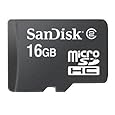Speeds
An SD card's speed is measured by how quickly an amount of information can be read from, or written to, the card. In applications that require sustained write throughput, such as video recording, the device might not perform satisfactorily if the SD card's class rating falls below a particular speed. For example, a camcorder built for a Class 6 card may suffer dropouts or corrupted video if a slower card is used. Digital cameras may experience a noticeable lag between shots, while the camera writes the picture to a slower card.
A card's speed depends on many factors, such as the following:
The likelihood of soft errors that the card's controller must re-try
The fact that, on most cards, writing data requires the controller to read and erase a larger region, then rewrite that entire region with the desired part changed
The possibility of fragmentation: that a body of information the host views as a unit is, for historical reasons, written to non-contiguous regions of memory. (This possibility does not cause rotational or head-movement delays as with magnetic media, but it does vary the amount of computation the card's controller must do.)
In early SD cards, the speed was measured with the × rating, which compared the average speed of reading data to that of the original CD-ROM drive. Currently, the official unit of measurement is the Speed Class Rating, which guarantees a minimum rate at which data can be written to the card.
The newer families of SD card improve card speed by increasing the bus rate (the frequency of the clock signal that strobes information into and out of the card). Whatever the bus rate, the card can signal to the host that it is "busy" until a read or a write operation is complete. Compliance with a higher speed rating is a guarantee that the card limits its use of the "busy" indication.
[edit] Speed Class Rating
32GB SDHC card
The Speed Class Rating is the official unit of speed measurement for SD cards. The class number guarantees a minimum write speed as a multiple of 8 Mbit/s (1 MB/s). The SD Association defines several speed class ratings, but manufacturers may claim conformance to those ratings without independent verification.
Unlike the earlier "×" speed ratings, the host device can read a card's speed class. A device can warn the user if the card reports a speed class that falls below an application's minimum need.[25]
These are the ratings of all currently available cards:[14][26]
Class Speed
SDHC Speed Class 2.svg Class 2 2 MB/s
SDHC Speed Class 4.svg Class 4 4 MB/s
SDHC Speed Class 6.svg Class 6 6 MB/s
SDHC Speed Class 10.svg Class 10 10 MB/s
Speed Classes 2, 4, and 6 assert that the card supports the respective number of MB/s as a minimum sustained write speed for a card in a fragmented state. Class 10 asserts that the card supports 10 MB/s as a minimum non-fragmented sequential write speed.[25] By comparison, the older "×" rating measured maximum speed under ideal conditions, and was vague as to whether this was read speed or write speed.
Recent developments
On 21 May 2009, Panasonic announced new class 10 SDHC cards, claiming that this new class is "part of SD Card Specification Ver.3.0".[27] Toshiba also announced cards based on the new 3.0 spec.[28]
On 1 June 2010, Pretec announced the new Class-16 HD-video grade SDXC 64 GB card at Computex Taipei 2010.[29]
[edit] UHS Speed Class
Requiring a new bus, the UHS Speed Class is intended for use in applications like real-time broadcasts and capturing large HD videos. The only currently available UHS SD cards are UHS Speed class 1.[31]






